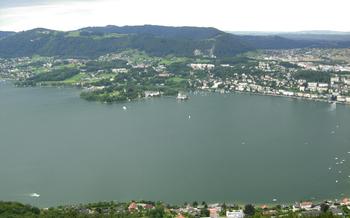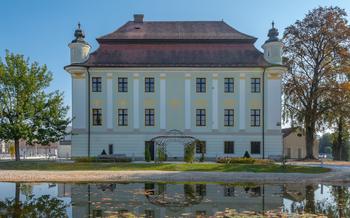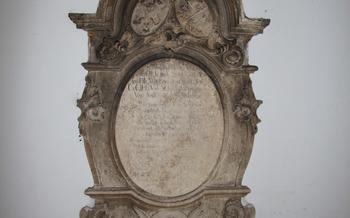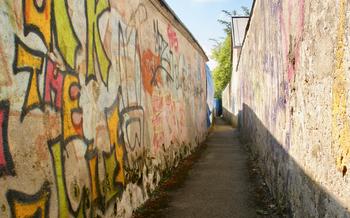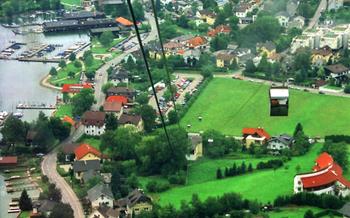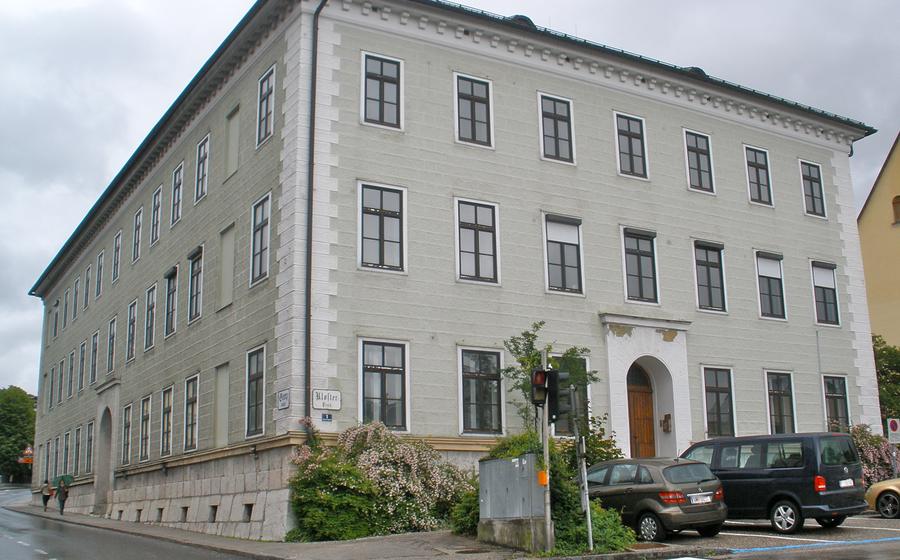
Seebahnhof (Railway Station Museum)
- Gmunden: A Charming Town on Lake Traunsee
- Seebahnhof: A Historic Railway Station Museum
- Location and Accessibility
- Museum Hours and Admission Fees
- Exhibits and Displays
- Interactive Experiences
- Guided Tours
- History of the Gmunden Railway
- The Golden Train
- The Locomotive Collection
- Railway Workshops and Maintenance
- Railway Stations and Infrastructure
- The Role of Railways in Tourism
- The Future of Railways in Austria
- Insider Tip: Explore the Hidden Gems of Gmunden
Gmunden: A Charming Town on Lake Traunsee
Nestled in the heart of the Salzkammergut region, Gmunden is a picturesque town renowned for its stunning natural beauty and rich cultural heritage. Situated on the shores of Lake Traunsee, Gmunden is surrounded by breathtaking Alpine landscapes that offer a feast for the eyes. With its historic buildings, charming streets, and vibrant atmosphere, Gmunden invites visitors to explore its many attractions, including the Seebahnhof, a unique railway station museum that offers a glimpse into the town's fascinating railway history.
Gmunden's history dates back to the 12th century, when it was a small fishing village. Over the centuries, it developed into a thriving trading center and a popular tourist destination. Its strategic location on the Traunsee and the construction of the railway line in the 19th century further contributed to its growth and prosperity. Today, Gmunden is a vibrant town with a population of around 13,000 people. It is known for its beautiful lakeside promenade, its historic town center, and its many cultural events and festivals.
Seebahnhof: A Historic Railway Station Museum
The Seebahnhof in Gmunden is not just a former railway station but a captivating museum that takes visitors on a journey through the rich history of railways in Austria. Once a bustling hub for trains traveling to and from Gmunden, this station has been meticulously transformed into a museum, preserving the legacy of the Gmunden railway line and showcasing the evolution of railway technology.
As you step inside the Seebahnhof Museum, you'll be greeted by an array of exhibits and displays that narrate the fascinating story of railways in the region. From vintage locomotives to historic railway memorabilia, the museum offers a glimpse into the past, showcasing the ingenuity and craftsmanship that shaped the development of rail transport in Austria.
Location and Accessibility
The Seebahnhof Museum is conveniently located in the heart of Gmunden, just a short walk from the picturesque Rathausplatz and the shores of Lake Traunsee. Its central location makes it easy to reach by foot or by bike, allowing visitors to explore the town's many other attractions and landmarks at their leisure.
For those arriving by car, there are several parking options nearby, including the Rathausplatz car park and the Seeparking Gmunden. The museum is also well-connected by public transportation, with the Gmunden Hauptbahnhof train station and several bus stops within easy walking distance.
Whether you choose to arrive by foot, bike, car, or public transportation, the Seebahnhof Museum is easily accessible and offers a convenient starting point for exploring all that Gmunden has to offer.
Museum Hours and Admission Fees
The Seebahnhof Museum is open to the public from Tuesday to Sunday, with varying hours depending on the season. During the summer months (April to October), the museum is open from 10 am to 5 pm, while in the winter months (November to March), it is open from 1 pm to 4 pm. Please note that the museum is closed on Mondays and certain public holidays.
Admission fees are affordable and cater to different visitor categories. Adults can purchase a ticket for €6, children between the ages of 6 and 15 can enter for €3, and families (two adults and two children) can enjoy a discounted rate of €Group discounts are also available for larger parties of 10 or more visitors.
Exhibits and Displays
The Seebahnhof Museum houses a diverse collection of exhibits and displays that delve into the rich history of railways in Austria. Visitors can marvel at a meticulously restored steam locomotive, a symbol of the early days of rail travel. The museum also showcases an impressive array of model trains, offering a glimpse into the intricate world of miniature railways.
Among the notable artifacts on display is a collection of historic railway uniforms, providing insights into the evolution of railway fashion and the changing roles of railway workers over the years. Visitors can also admire a variety of railway tools and equipment, such as signal lamps, lanterns, and track gauges, which offer a glimpse into the behind-the-scenes operations of a railway.
Interactive displays and multimedia presentations bring the history of railways to life, allowing visitors to experience the sights and sounds of a bustling railway station. Through these interactive elements, visitors can learn about the challenges and triumphs of railway engineering, the impact of railways on society, and the role of railways in shaping the landscape of Austria.
Interactive Experiences
Beyond the static exhibits, the Seebahnhof Museum offers a range of interactive experiences to engage visitors and provide a deeper understanding of railway operations. Visitors can step into the driver's cabin of a locomotive and experience the thrill of operating a train simulator. Interactive displays allow visitors to explore the inner workings of railway signals and switches, simulating the tasks of a signalman. For children, a dedicated play area offers model trains and educational games, fostering their interest in railways from a young age. These interactive elements make the Seebahnhof Museum an immersive and educational experience for visitors of all ages.
Guided Tours
The Seebahnhof Museum offers guided tours that provide visitors with a deeper understanding of the history of railways in Austria, the Gmunden railway line, and the exhibits on display. These tours are led by knowledgeable guides who share insights into the technical aspects of railway operations, the significance of the Golden Train, and the evolution of locomotive technology.
Guided tours are available in German and English, and can be booked in advance to ensure a spot. The tours typically last for about an hour and cover the highlights of the museum, including the locomotive collection, the railway workshops, and the history of the Gmunden railway line.
Taking a guided tour is a great way to learn more about the fascinating world of railways and gain a deeper appreciation for the role they played in the development of Gmunden and the surrounding region.
History of the Gmunden Railway
The Gmunden railway line, a crucial part of the Austrian railway network, boasts a rich and storied history. Its construction began in 1872, driven by the need to connect the picturesque town of Gmunden to the burgeoning railway system of the Austro-Hungarian Empire. Completed in 1877, the line played a pivotal role in transforming Gmunden into a thriving tourist destination. Before the advent of the railway, visitors had to rely on horse-drawn carriages or boats to reach Gmunden, a journey that was both arduous and time-consuming. The railway, with its regular and reliable service, made Gmunden far more accessible, opening it up to a wider range of tourists eager to experience its natural beauty and cultural attractions. The Gmunden railway line also played a significant role in the economic development of the region. It facilitated the transportation of goods and materials, fostering trade and commerce. The construction of the railway also created employment opportunities, providing jobs for local workers during its construction and operation.
The Golden Train
Among the many attractions at the Seebahnhof Museum, the "Golden Train" holds a special place. This luxurious train, once a symbol of opulence and elegance, operated on the Gmunden railway line, captivating passengers with its grandeur and comfort.
The Golden Train was introduced in 1925, catering to the needs of discerning travelers who sought an exceptional journey. Its gleaming golden exterior, plush velvet seats, and exquisite dining facilities made it a sight to behold. The train's reputation for impeccable service and attention to detail quickly made it a favorite among the elite and wealthy.
One of the most memorable anecdotes associated with the Golden Train is the story of a wealthy industrialist who proposed to his beloved on board. The train's romantic ambiance and stunning views provided the perfect backdrop for this special moment, creating an unforgettable memory for the couple.
The Golden Train continued to operate until the outbreak of World War II, when it was sadly decommissioned. Today, visitors to the Seebahnhof Museum can admire a replica of this iconic train, which stands as a testament to the opulence and glamour of a bygone era.
The Locomotive Collection
The Seebahnhof Museum boasts an impressive collection of locomotives that showcases the evolution of locomotive technology and the rich history of the Gmunden railway line. Visitors can marvel at a variety of steam, diesel, and electric locomotives, each with its own unique story to tell.
Among the highlights of the collection is the Gmunden 1 locomotive, the oldest preserved locomotive in Austria. Built in 1853, this steam locomotive played a crucial role in the early days of the Gmunden railway, hauling passengers and freight along the scenic lakeside route.
Another notable locomotive is the ÖBB 52 diesel locomotive, which represents a significant chapter in the transition from steam to diesel power on Austrian railways. Introduced in the 1950s, these locomotives were known for their reliability and efficiency, and they played a vital role in modernizing the country's railway network.
Visitors can also admire the sleek and powerful ÖBB 1044 electric locomotive, which represents the latest generation of locomotives in Austria. These modern locomotives are capable of reaching speeds of up to 200 kilometers per hour, making them essential for high-speed rail travel.
The locomotive collection at the Seebahnhof Museum offers a fascinating glimpse into the history of railway transportation in Austria, showcasing the technological advancements that have shaped the country's railway system over the years.
Railway Workshops and Maintenance
In addition to the locomotives and carriages, the Seebahnhof Museum also houses a collection of railway workshops and maintenance facilities. These workshops were once used to maintain and repair the locomotives and carriages that operated on the Gmunden railway line. Today, they provide a glimpse into the behind-the-scenes operations of a railway system.
The workshops are equipped with a variety of tools and machinery, including lathes, milling machines, and welding equipment. Visitors can see how the locomotives and carriages were repaired and maintained, and learn about the skills and expertise required to keep a railway running smoothly.
The maintenance facilities include a roundhouse, where the locomotives were stored and serviced, and a turntable, which was used to turn the locomotives around. Visitors can learn about the different tasks that were carried out in the workshops, such as cleaning, lubrication, and repairs, and how these tasks ensured the safe and efficient operation of the railway.
Railway Stations and Infrastructure
The Gmunden railway line features a variety of railway stations, each with its own unique character and significance. Gmunden station, the main station on the line, is a beautiful example of Art Nouveau architecture and serves as a gateway to the town and its surrounding attractions. Altmünster station is a smaller station with a charming rustic appearance, while Traunkirchen station offers stunning views of Lake Traunsee and the surrounding mountains.
Along the line, several bridges and tunnels were constructed to overcome geographical challenges and ensure a smooth and safe journey. The Traunbrücke, a magnificent steel bridge, spans the Traun River and offers breathtaking views of the surrounding landscape. The Traunkirchner Tunnel, meanwhile, is a testament to the engineering prowess of the railway builders, allowing trains to pass through a mountain range and emerge into the picturesque village of Traunkirchen.
Signals play a crucial role in ensuring the safe operation of the railway. The Gmunden railway line is equipped with a sophisticated signaling system that regulates the movement of trains and prevents accidents. These signals, with their distinctive colors and patterns, add a touch of visual interest to the railway line and serve as a reminder of the complex infrastructure that supports the smooth running of trains.
The Role of Railways in Tourism
The Gmunden railway line played a crucial role in the development of tourism in the region. Before the construction of the railway, Gmunden was a relatively isolated town, accessible mainly by boat or carriage. The railway line connected Gmunden to the rest of Austria and made it easier for visitors to reach the town and explore its surrounding attractions.
The railway also made it possible for Gmunden to develop as a summer resort town. In the late 19th and early 20th centuries, wealthy Viennese families would flock to Gmunden to escape the heat and crowds of the city. The railway made it easy for these visitors to travel to Gmunden and enjoy the town's beautiful scenery, fresh air, and many recreational activities.
The railway also helped to promote tourism in the Salzkammergut region as a whole. The region is home to many beautiful lakes, mountains, and villages, and the railway made it possible for visitors to easily travel between these destinations.
Today, the Gmunden railway line continues to be an important part of the region's tourism industry. The line is used by both tourists and commuters, and it helps to connect Gmunden to the rest of Austria and Europe.
The Future of Railways in Austria
Austria has a long and rich history of railway transportation, and the Gmunden railway line is a testament to the importance of railways in the country's development. Today, railways continue to play a vital role in Austria's transportation system, providing efficient and sustainable travel options for both passengers and freight.
The Austrian government is committed to the future of railways, and there are several initiatives underway to modernize and expand the country's rail network. These include investments in new rolling stock, upgrades to infrastructure, and the development of new high-speed rail lines.
One of the most ambitious projects is the Brenner Base Tunnel, a 64-km long tunnel that will connect Austria and Italy under the Alps. The tunnel is expected to be completed in 2032 and will significantly reduce travel times between the two countries.
Another important initiative is the expansion of the S-Bahn network in Vienna and other major cities. The S-Bahn is a commuter rail system that provides fast and frequent service to suburban areas, and its expansion will help to reduce congestion and improve air quality in urban areas.
These initiatives demonstrate Austria's commitment to a sustainable future for rail transportation. By investing in railways, Austria is ensuring that the country will continue to have a reliable, efficient, and environmentally friendly transportation system for years to come.
Insider Tip: Explore the Hidden Gems of Gmunden
After your visit to the Seebahnhof Museum, take some time to explore the hidden gems of Gmunden. Stroll along the picturesque Esplanade, a beautiful promenade that offers stunning views of Lake Traunsee and the surrounding mountains. Visit the Gmunden Keramik Manufaktur, a renowned ceramics factory that has been producing high-quality porcelain since 186Indulge in a delicious cup of coffee and a slice of cake at one of the charming cafes in the town center. Don't miss the opportunity to take a boat trip on Lake Traunsee, which offers breathtaking views of the region's natural beauty. Whether you're interested in history, culture, or simply relaxing in a stunning setting, Gmunden has something to offer everyone.
